



Republic of Korea Livestock and Products Semi-Annual Report 2009
In 2009, total beef imports to South Korea are expected to decline by 12 per cent and total pork imports by five per cent due to the economic situation and the depreciation of the Korean won vis-à-vis the strong US dollar, according to teh USDA Foreighn Agricultural Service. However, US beef imports are expected to increase substantially in 2009 as more grocery stores and restaurants begin making it available for consumers. US pork imports will fall slightly due to the increased competition of US beef.Section I. Situation and Outlook
Much like the rest of the world, the outlook for the South Korean economy this coming year
has grown increasingly bleak. However, unlike other Asian economies, the situation in South
Korea has deteriorated faster than expected due to the collapse of the export market. Even
during the 1997/98 Asian economic crisis there was still a healthy demand for Korean
products, but exports have continued to decline by double digits.
In September 2008, the Korean economy was expected to grow in 2009 by about five to six
percent; however, it is now expected to contract by two to four percent. Domestic
consumption is also expected to decline. The future Consumption Sentiment Index (CSI)
dropped to 91 in February 2009 from 106 in September 2008 indicating that more
consumers are anticipating reducing their consumption in 2009. Sales of consumer goods
are dropping to levels not seen since December 1998. As far as meat consumption is
concerned, it is expected that consumers will shift to lower priced proteins, which are
generally pork and poultry in Korea. However, as can be seen by the chart below, the price
of some imported beef cuts is not that much higher than the price of domestic pork.
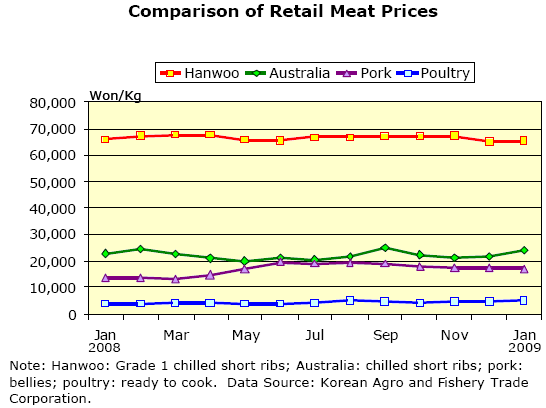
Since the Lehman Brothers bankruptcy on September 12, 2008, the Korean won has
depreciated by 36.7 percent (from 1,109.1 won to 1,516.3 won per U.S. dollar.) Most
analysts are now predicting that it will stabilize at around 1,500-1,600 won to the U.S. dollar.
This has caused the price of imported meat to rise to the point where importers are forced to
sell at a loss. Industry sources state that the importers are loosing 50–60 million won
($33,000-$40,000) for every 40 feet container of short ribs they sell due to the poor
exchange rate. In Korea, 30 percent of meat is sold through retail outlets, 10 percent is
used for processing and 60 percent is sold through the restaurant sector. A recent survey by
the Korea Chamber of Commerce indicates that all consumers are reducing the amount of
spending on dining out, but younger consumers in their 20s who tend to dine out more
frequently have reduced their spending by 37.3 percent.
Importers are also facing a credit crunch that is hindering them from purchasing more
products. Sales have been slow and inventories are high. As a result, the GSM program has
been widely popular in Korea, but the current allocation of $600 million has been used and
an additional allocation has not been forthcoming. It is very likely that many importers will
go out of business in 2009 further consolidating meat import channels.
Per capita consumption of beef and pork has continued to increase in 2008, although both
are expected to decline slightly in 2009 due to the economic climate. The graph below
shows an increase in per capita consumption of beef in 2009, but post disagrees with the
projection by the Korea Rural Economic Institute (KREI) as too optimistic.
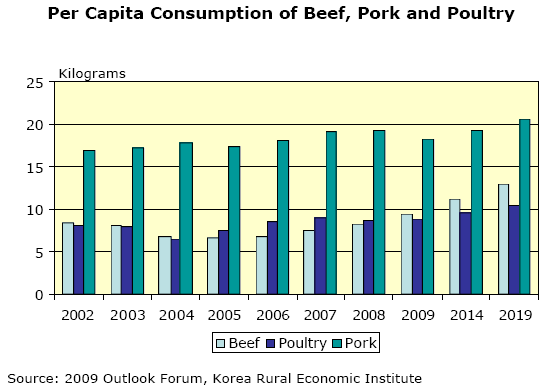
Section III. Narrative on Supply and Demand, Policy and Marketing
Cattle Production
In 2009, production will fall further than was originally expected due to the continued
sluggishness in calf prices. Calf prices started out the 2008 year at 1.97 million won in
January, but hit bottom at 1.34 million won in August and only reach 1.35 million won by
December. As a result, farmers further reduced their use of artificial insemination (AI). In
Korea, over 90 percent of cattle are artificially inseminated. Farmers are well aware that the
average cost of AI is more than offset by the increased price they receive for higher quality
beef. In fact, animals that only receive a grade 2 or 3 end up loosing money, so farmers
will continue to use AI even during a time of economic downfall. Therefore, the reduction in
semen sales by 6.7 percent will directly correlate to a reduction in cattle production for the
next year.
| Estimate of 2008 Income of Feeder Cattle by Grade (Unit: 000 won per head) | |||||
|---|---|---|---|---|---|
| Grade | |||||
| Gross income | 6,6501++ | 5,9651+ | 5,3911 | 4,6882 | 3,7793 |
| Net Income | 1,810 | 1,125 | 551 | -152 | -1,061 |
| Source: Korea Rural Economic Institute | |||||
The government has increased its 2009 budget to support Hanwoo farmers from 403.4 billion
won (about $269 million) in 2008 to 530.9 billion won ($about 354 million). This budget will
be used to increase the productivity of Hanwoo cattle by improving its quality, establishing
large livestock marketing companies, and facilitating the direct sales by producer groups in
order to cut down on the marketing costs.
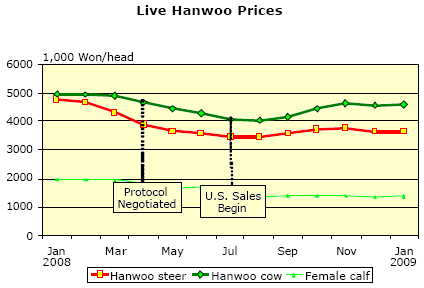
Cattle Slaughter
The downtown in the economy and higher feed prices in 2009 will result in higher slaughter
rates. Although the price of feed grain has been dropping in 2008, in Korea this has been
offset by higher exchange rates and compound feed prices will continue to be a burden on
cattle producers.
Slaughter was originally forecast to increase only slightly due to farmer anxiety over
increased competition from U.S. beef imports; however, this did not materialize as the
impact of U.S. beef sales on Hanwoo prices was much less than farmers anticipated. It is
now expected that slaughter will increase by a greater amount (12.5%) as the economic
climate worsens. Although of inferior quality, Hanwoo grade #3 and dairy steers grade #1+
are preferred by Korean consumers over imported beef. Because these dairy steers are in
direct competition with imported beef, farmers are going to be reluctant to increase their
herd size and in fact, will slaughter at higher rates.
The prices for beef from dairy cattle have continued to drop in the latter half of 2008. The
dairy industry had been trying to promote the consumption of milk by giving consumers a
bottle of milk for every one purchased; but this promotion was stopped in August 2008 due
to higher input prices. The farm-gate price of raw milk increased by 20.54 percent in August
causing milk prices to rise in the fall of 2008. Although, the free giveaways have resumed in
2009, higher retail milk prices will keep milk consumption low and the price of dairy calves
will continue to fall. To counter this decline, the government has been purchasing dairy
calves from farmers and providing them free to feedlots. As a result, feedlot inventories
have increased and the rate of slaughter is expected to grow as inferior cattle are culled.
There is little incentive to continue feeding these calves as only animals that receive a grade
1 or higher will earn a profit.
Ending Inventories
Ending inventories were adjusted slightly to account for the greater forecasted drop in production. Although production is forecast to drop and slaughter is forecast to increase in 2009, ending inventories will increase by only a small amount in 2009 as it will take two years for cattle inventory to fully adjust. In addition, calf production is still greater than slaughter. Inventory is not expected to decline until 2010.
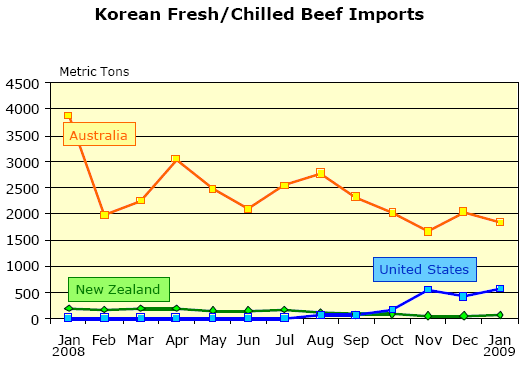
Beef Production
Domestic beef production is now forecast to increase by 15 percent as more cattle are slaughtered due to higher feed prices and higher inventory levels.
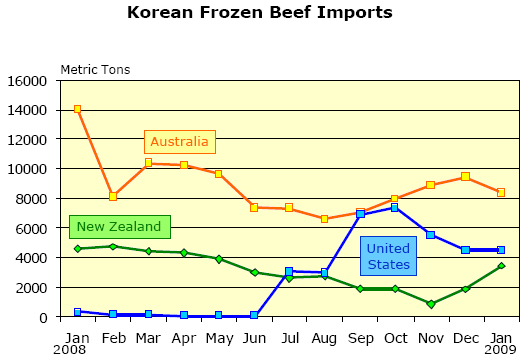
Beef Imports
Imports of U.S. beef are forecast to grow at a slower rate than originally anticipated due to
several factors. First and foremost is the economic situation, consumers are spending less.
Then, the depreciation of the Korean won vis-à-vis the strong U.S. dollar is making U.S. beef
less price competitive against Australian beef. Since September 2008, both currencies have
appreciated against the Korean won, but the Australian dollar much less so.
U.S. beef faces an additional challenge of countering the negative image developed during
the protests this past summer. This is especially true of the younger generation who were
initially the majority of the protesters. Misinformation spread through cell phones, the
internet, and even by teachers is going to take a lot of time and effort to clear up before
these customers return. A survey of 818 people by the Korea Rural Economic Institute
revealed that only 15.8 percent had purchased U.S. beef in 2008 and only 26.0 percent had
any plans to purchase U.S. beef in 2009.
Despite this, U.S. beef is slowly increasing its availability in the Korean market. The top
three hypermarkets began selling U.S. beef at the end of November and although there are
still many medium-sized grocery stores that are not yet carrying it, the number is growing.
Unfortunately, restaurants have been very slow to resume purchasing U.S. beef. The initial
sales price of U.S. beef was a lot higher than many expected and due to the new country-oforigin
labeling laws, there was little incentive to switch. Nevertheless, restaurants tend to
take their cue from retail sales and now that more retail outlets are beginning to carry U.S.
beef, it is likely that restaurant sales will follow.
Competition from Australia
U.S. beef faces stiff competition from Australia. The quality of Australian beef has vastly
improved since 2004 and it is now well known for its high marbled Wagyu beef. Consumers
tend to prefer purchasing Australian beef and believe it is safer. In fact, several retailers
have recently been found mislabeling U.S. beef as Australian beef.
Beef imports from Australia are traded using U.S. dollars. Thus, the depreciation of
Australian dollar against U.S. dollar of 23.2 percent (From $1.245 Australian dollar per one
U.S. dollar to $1.534 Australian dollar per for one U.S. dollar) since September 12, 2008,
would mean that Australia can get the same price in Australian dollars if it increases its price
by 23.2 percent. However, during the same period, the Korean won depreciated its value by
36.7 percent against the U.S. dollar (From 1,109.1 won per one U.S. dollar to 1,516.3 won
per one U.S. dollar). This means that U.S. beef prices would be 36.7 percent more
expensive than in September 2008.
Swine Production
Given the high swine prices at the time, it was originally expected that swine production
would increase; however, high feed prices and the drop in the price of sows reversed that
trend. The prices for fully grown sows peaked in August and then started to drop in
September. When prices are dropping, farmers begin slaughtering in higher quantities. Also,
unlike cattle that is fed with roughage and compound feed, swine is completely raised with
compound feed. Feed prices continued increasing up to December 2008. It is estimated that
over 1,000 farmers, unable to sustain the high production costs, gave up farming during the
fourth quarter of 2008. This has caused sow inventory numbers to drop during the last
quarter and production is now expected to decline slightly.
The government's vaccination program that began in May 2008 against major swine
diseases, such as PRRS, will gradually increase the MSY (market piglets per sow per year) in
2009 and as a result, despite the drop in sow numbers (9.1 percent) in 2009, the piglet
numbers are expected to drop at a slower rate (2.3 percent).
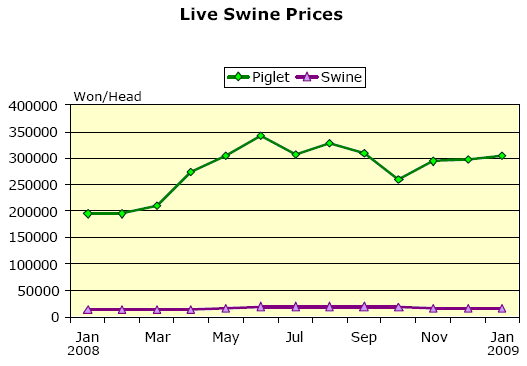
In addition, the Korean government has recently announced that conglomerates will be able
to purchase hog operations. In the past, this has not been allowed as it makes smaller farms
less competitive. Since this announcement, smaller farms have been going out of business.
It will be more difficult for the smaller, less competitive farms to pay the higher costs
associated with environmental regulations and expected higher feed costs in 2009. The
world corn price that hit the bottom in December 2008 has turned its nose upward in
January 2009. Such increase in corn prices coupled by the depreciation of the won currency
against U.S. dollars will diffuse the hopes for lower feed prices in 2009, which will aggravate
the small farmers’ revenue and will push these farmers out of business.
Swine Slaughter
Swine slaughter was forecast to decrease; however, it is now expected that the decrease will be greater than anticipated given the lower production levels.
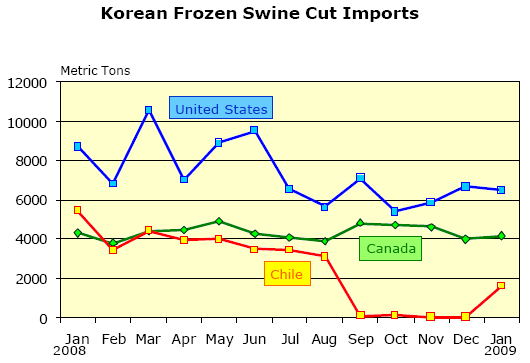
Pork Imports
In August 2008, it was expected that pork imports would increase; however, given the economic downturn, the depreciation of the Korean won, and the lack of credit available to importers, it is now forecast that imports will fall. Additionally, pork production in major supplying countries, such as the United States and the European Union, is expected to fall in 2009, which will lead to higher prices. Lastly, the country of origin labeling requirement for pork went into effect on December 22, 2009 and this reduced the use of imported pork at restaurants.
Pork Exports
Efforts to eradicate the hog fever diseases in Jeju Island have been successful. The industry hopes to resume pork exports to Japan, which used to be the largest export market for Korean pork, during the second half of 2009.
Pork Consumption
Pork consumption is forecast to drop further than was originally expected. In some ways, 2008 has been an abnormal year for pork consumption. The controversy over U.S. beef and the outbreak of avian influenza caused many consumers to switch to pork. This high demand kept pork prices high throughout 2008 and this is likely to continue in 2009 due to tight supplies. Pork will face increasing competition from other meats. For example, the price of domestic pork bellies, the most popular cut in Korea, is not much less than the price of imported frozen chuck roll or rib eye cuts and it is higher than the price of poultry. Unless there is another highly publicized issue, consumers will gradually shift to other meats.
Further Reading
| - | You can view the full report by clicking here. |
March 2009


